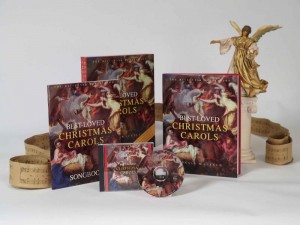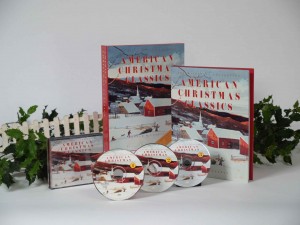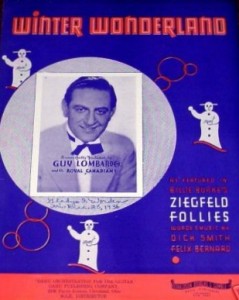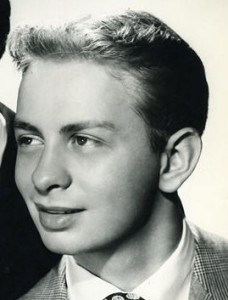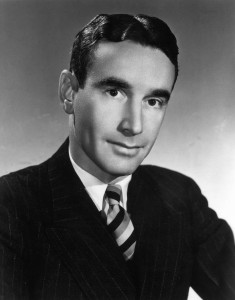Stan Zabka’s Classic Christmas Eve Song
For those unfamiliar with the name, Stan Zabka, think Americana and you’ll hear on this Christmas Eve his appropriately-named holiday classic (and one of my favorite holiday tunes) – Christmas Eve In My Home Town.
Resplendent with home town images and themes, especially as it is performed by the iconic Kate Smith, the carol was written during a very difficult time when American soldiers were engaged in another foreign war. Stan Zabka, along with Don Upton, another ex-GI, wrote Christmas Eve in My Home Town in 1951 at the height of the Korean War. The song became an immediate hit with soldiers in the field and sailors at sea, eventually earning sobriquets as The Soldier’s Christmas Song, and the Official Christmas Song of Radio Free Europe during the Cold War years.
In 1966 during the Vietnam War, Kate Smith wanted to do something special for American troops by recording 36 individual messages on the Armed Forces Network, which then aired them around the world wherever our troops were stationed or on ships at sea. In her folksy and heart-warming voice, she addressed her armed forces audience: “Hello boys and girls, this is Kate Smith coming to you via Armed Forced Radio with a greeting to let you know that we are all thinking of you. I have recorded a song especially for you. It was written by a couple of ex-GIs, Stan Zabka and Don Upton, and you will be hearing it soon. Its title is Christmas Eve in My Home Town. And boys and girls, Christmas won’t be the same without you, but you can bet that you will be thought of, and prayed for, and loved just as much as if you were all here. I would like to say Merry Christmas to you and may God bless you all.”
On another occasion when our troops entered Kuwait in September 1990, the U.S. government forbade Western Christmas music to be broadcast because Kuwait was a Muslim country. However, it was Kate Smith’s special Armed Forces Network message and introduction of the song on the Johnny Carson Tonight Show that convinced the government to lift its restriction. What may have also helped to get the message out was the affable Zabka, a three-time winning composer, musician, and director, once served as an associate director with NBC-NY and for five years had a close working relationship with Johnny Carson and the Tonight Show.
This Christmas Eve if you want to experience the warm glow of the season and the sound of a more innocent time in American history, richly illuminated by the one and only Kate Smith, tune into Zabka’s nostalgic classic: Christmas Eve in My Home Town. His homey lyrics truly capture the spirit of the season and the nostalgic long ago, an essential ingredient of AMERICAN CHRISTMAS CLASSICS.
There’s so much to remember!
No wonder I remember
Christmas Eve in My Home Town.
Carols in the square,
Laughter everywhere,
Couples kissing under the mistletoe.
I can’t help reminiscing,
Knowing I’ll be missing
Christmas Eve in My Home Town.
Nothing can erase
Mem’ries I embrace
Those familiar footprints upon the snow!
There’s so much to remember!
No wonder I remember
Christmas Eve in My Home Town.
I’d like to be there,
Trimming the tree there,
And there’s a chance that I might!
I can hear singing,
Steeple bells ringing
Noel and Silent Night.
Wise men journeyed far
Guided by a star,
But, though I’m not a wise man,
This I know:
Through dreams and just pretending,
I’m there and I’ll be spending
Christmas Eve in My Home Town.
© Big Island Music, Inc.

Stan Zabka at the piano
Not too Late! Great Christmas Gifts for Military Families
It’s not too late! Please RT about Christmas Classics Ltd. support of the Fisher House Foundation this Christmas season. PRESS RELEASE
A great provider of free housing and comfort for military families in need of special medical care, the reputable foundation will benefit from the sale proceeds of Christmas Classics Ltd.’s two highly acclaimed Christmas music box collections, Best-Loved Christmas Carols and American Christmas Classics.
In addition, these premier collections are being donated to thirty-three Fisher Houses located across the country.
With the purchase today of Christmas Classics prized collections, described by customers and media alike as “great gifts,” you will make this Christmas season truly memorable, not only for your family and friends, but also for many of our military families who have suffered so much and yet have asked so little.
Merry Christmas!
Ronald M. Clancy
www.christmasclassics.com
Christmas Classics PERSON OF THE DAY: James Kimball Gannon
On this day in 1900, James Kimball Gannon was born in Brooklyn, New York. Better known as Kim Gannon, he was an American songwriter and lyricist for the perennial Christmas favorite I’ll Be Home for Christmas.
Gannon attended St. Lawrence University and as a senior wrote the school’s alma mater song The Scarlet and the Brown. A proud graduate of St. Lawrence in 1924, he had every intention of becoming a lawyer. The Great Depression delayed that career pursuit and in 1930 he was working as a salesman for a utility company. By 1934 he passed the New York state bar examination, but five years later the songwriting bug struck and soon after he composed his first commercial song, For Tonight.
The year 1942 found Gannon writing songs during the “swing era” and for films including the lyrics of the film title song Always in My Heart that earned him an Academy Award nomination for Best Song. He replicated that achievement twice more: 1) Too Much In Love for the film Song of the Open Road in 1944, and 2) Endlessly in 1945 for the film Earl Carroll Vanities. But in between he collaborated with Walter Kent in 1943 to produce I’ll Be Home for Christmas. Gannon also wrote songs for the films Powers Girl and If Winter Comes before Broadway beckoned in 1951 when he teamed up with Walter Kent again on the score for Seventeen.
Despite his success with film and Broadway, Gannon is best remembered for his popular and wistful Christmas lyric I’ll Be Home for Christmas. First recorded by Bing Crosby in 1943, it has since been recorded more than three hundred times and is an important part of American Christmas Classics.
The amiable Kim Gannon, who died in 1974, was always true to his alma mater. In his will he stipulated that after his wife Norma’s passing (she died in 2006), 30% of all royalty proceeds from his songs were to go to St. Lawrence University. The majority of those royalties, you can bet, come from his 39-word holiday classic I’ll Be Home for Christmas.
Christmas Classics PERSON OF THE DAY: Richard B. Smith
On this day in 1901, the little known Richard B. Smith was born in Honesdale, Pennsylvania. He was the lyricist (Felix Bernard wrote the music) of the popular Christmas song Winter Wonderland that was first recorded by Guy Lombardo in 1934. Unfortunately for Smith, who was diagnosed with tuberculosis in 1931, he never got to enjoy the success that came to his classic song after succumbing to the disease in 1935, thus aborting what looked to be a promising career.
Smith had attended Penn State University, majored in advertising, and was responsible for editing the school magazine. His interest in music was also on display there when he formed and conducted his own orchestra. After graduating from Penn State, Smith moved to New York and began a career as a newspaper editor. The music bug, however, never left him as he took on the management of several Broadway theaters.
The Pennsylvania lyricist got married in 1931. Shortly after the happy event he was stricken with the dreaded tuberculosis and soon was admitted to the West Mountain Sanatorium where his wife was a nurse. With his wife near to his side, Smith’s talent for songwriting blossomed as he produced When A Gypsy Makes a Violin Cry, Bringing My Honey Back to Me, and the popular Winter Wonderland while convalescing, all of which caused Hollywood to come knocking. Before long Smith gladly agreed to a contract to write music for films; but a month before he was to go to California he passed away.
The inspiration for Winter Wonderland, a delightful addition to American Christmas Classics supposedly came from familiar winter snow scenes Smith remembered from life near the Pocono Mountains. Eight years after his passing, his song made it to the top of the charts and it has since become a perennial favorite during the Christmas season.
Christmas Classics PERSON OF THE DAY: Jack Rollins
On this day in 1906, Walter E. “Jack” Rollins was born in Scottdale, Pennsylvania. Better known as Jack Rollins, he is the songwriter credited with co-writing, supposedly with Steve Nelson, the Christmas holiday song Frosty the Snowman that is part of AMERICAN CHRISTMAS CLASSICS. That success came in 1950, just a year after Rollins, and supposedly Nelson again, collaborated on the popular Easter song Here Comes Peter Cottontail.
Rollins also co-wrote the song Smokey the Bear in 1952 after a wildfire swept across the Capitan Mountains in New Mexico, during the course of which firefighters noticed a lone bear cub climbing up a charred tree to escape being further burnt from the flames. The cub was rescued from his perch and given immediate veterinary care and ultimately was sent to the National Zoo in Washington. The story about the bear cub and its rescue lead to a national public service campaign to prevent forest fires with Smokey the Bear serving as mascot.
Rollins achieved a fair level of success with his children’s holiday songs, especially with the Gene Autry recording of Frosty the Snowman that sold over a million records. Rollins also co-wrote others songs for such country singers as George Jones and Eddie Arnold. Success, however, seemed to have come late in his career, one dotted with menial jobs. In 1940 he worked for a bakery. Eight years later he was a baggage clerk for Penn Station in New York. It was at that time when the 44 year old baggage clerk found the time to pen Frosty the Snowman and a number of other songs, and practically every night Rollins used to ask Frank (Zeb) Martello, the host of WOR mutual radio, to play them.
According to a letter from a Martello family member, Rollins and the radio host became friends and together they may have written five songs, including Rollins’ two most popular holiday songs Frosty the Snowman and Peter Cottontail. But Rollins asked Martello to take his name off the songs because some other well-known people, including “a guy by the name of Steve Nelson, for one, wanted his name on the songs before he would promote them.”
After the two songs became big hits, Martello was asked by his wife why he had removed his name from the two songs, insisting that he was always being the nice guy. Martello replied “Jack has a lot of talent, he deserves a break.” When asked if he ever regretted doing that, Martello said, “not really, but I guess mom could have used the money.”
Jack Rollins died in Cincinnati on January 1, 1973. The kind-hearted Zeb Martello on hearing the sad news was quoted to have said, “God Bless Jack, but I still have a lot to be thankful for.”
Christmas Classics PERSON OF THE DAY: Mel Tormé
On this day in 1925, Melvin Howard Torma, better known as Mel Tormé, was born in Chicago to a Russian Jewish family. He was an accomplished and well-liked jazz composer, scat singer, author, and actor for television and movies. In Christmas music circles he is best known as co-author, along with Robert Wells, of The Christmas Song (a.k.a. Chestnuts Roasting on an Open Fire).
During the World War II years Tormé moved to California, enlisted in the Army, and started his own quintet Mel Tormé & the Mel-Tones. B y 1947 he decided to strike out on his own and then went on to develop a reputation as a cool jazz singer. He did not disappoint in 1948 with Careless Arms, a number one hit. In all “The Velvet Fog” a sobriquet Tormé detested, is credited with 250 songs and the arranger for a host of songs he sang for several recording companies, including Decca and Capitol Records. For a time in the 1960s he was the principal song writer and music arranger for The Judy Garland Show and by the 1970s with the resurgence of jazz singing his career was revitalized and from that time forward he remained a presence in the jazz world until his death.
How Tormé became associated with one of the most popular Christmas songs for the past seven decades is one for the books. During a terrific heat wave besieging Los Angeles in July of 1945, the songwriter Robert Wells sat at his piano and tried to find solace from the heat by jotting down several lines of lyrics with wintry themes. “It was so damn hot, I thought I’d write something to cool myself off,” he once said. “All I could think of was Christmas and cold weather.” While in this mood, his good friend Mel Tormé paid a visit. When Tormé noticed the notes Wells had put to paper, he suggested to him that they just might have the beginnings of a Christmas song.
Within twenty or forty-five minutes, depending upon who’s telling the story, the two songsters produced The Christmas Song. Tormé then went to the home of Nat King Cole and convinced him to record the song, and in the Spring of 1946 Nat went into a New York recording studio with a simple piano version of the song. The initial results weren’t satisfactory, and at the urging of his wife Maria and manager, the mellifluous singer responded with a more highly regarded version with strings and full orchestra. It was Cole’s exquisite recording that popularized the song, and over the years The Christmas Song has consistently ranked as one of America’s seasonal favorites.
Considered an historic recording, the song was honored in 1999, as was Tormé himself for life time achievement, by being inducted by the Grammy Awards organization into its Hall of Fame.
The Christmas Song has truly stood the test of time. This is quite understandable because it was written during an age when composers like Tormé produced music marked by grace and charm. In retrospect it is easily understood why his passing was mourned by many, especially by those nostalgic for such memorable musings from “Chestnuts roasting on an open fire” . . . to . . . “And so I’m offering this simple phrase, To kids from one to ninety-two; Although it’s been said many times, many ways, “Merry Christmas to you.”
Christmas Classics PERSON OF THE DAY: Bobby Helms
On this day in 1933, Robert Lee Helms was born in Bloomington, Indiana. Better known as Bobby Helms, he was a country singer and the original recording artist of Jingle-Bell Rock, the first Christmas holiday song noted for its rock n’ roll flavor. It was released by Decca Records on December 23, 1957, a hundred years after the copyright of Jingle Bells, which may not have been totally coincidental. The song rapidly rose to #6 on the Pop Charts and has since been reprised every Christmas season.
Bobby Helms rise to stardom actually began earlier that year with the release of Fraulein, a country song, which to the surprise of country aficionados, fared well on the pop charts, and later in 1957 with My Special Angel, Helms’ biggest hit that sold over a million records.
Jingle-Bell Rock, however, was the brainchild of an very unlikely pair of the songwriters: Joseph Carleton Beal, a public relations man and author, and Texas-born James R. Boothe whose career was largely devoted to advertising. Jingle-Bell Rock was their sole claim to fame in the world of Christmas music.
Although Bobby Helms continued a productive career in country music that included touring with his Bobby Helms Show and promoting a yearly musical festival in his native Indiana, not to mention he owned three night clubs, he never again achieved the soaring heights when Jingle-Bell Rock topped off what was a very, very good year.
Christmas Classics PERSON OF THE DAY: Hugh Martin
On this day in 1914, Hugh Martin was born in Birmingham, Alabama. He was a composer for both the Broadway stage and films and is credited for co-writing along with his long-time collaborator, Ralph Blane, the popular holiday classic Have Yourself a Merry Little Christmas, as well the other songs for the Hollywood musical Meet Me in St. Louis starring Judy Garland. Martin and Blane did indeed collaborate on a number of Broadway musicals for several decades. In his autobiography, however, Martin claimed he was solely responsible for the music and lyrics of Have Yourself a Merry Little Christmas.
Martin wrote the song’s first draft while vacationing at a Birmingham house his father designed for his mother. That draft was judged too depressing by Judy Garland, her co-star Tom Drake, and Vincente Minnelli, the movie director and future husband of Garland. The dispirited Martin was reluctant to change the lyrics, but then went about the task of revising them to accommodate his initial critics. What resulted was a more upbeat, though wistful, tune that Garland eventually sang in the musical and later as a single for Decca Records. Her sentimental version was known to have caused many a tearful eye, especially among U.S. troops serving in World War II.
Over the years some of the original verse lines of Have Yourself a Merry Little Christmas were further changed. For Frank Sinatra and his 1957 album A Jolly Christmas, Martin revised the original line “Until then we’ll have to muddle through somehow” to the more familiar and popular phrase “Hang a shining star upon the highest bough.” In later years the line “through the years, we all will be together if the Lord allows,” was replaced by the less religious “if the fates allow.”
Hugh Martin died of natural causes on March 11, 2011 at his home in Encinitas, California. At his bedside were his niece Suzanne Hanners, and Elaine Harrison his long-time manager and best friend.
Christmas Classics PERSON OF THE DAY: Billy Hayes III
On August 12, 1993, Billy Hayes III died in his home town of Brooklyn, New York. The songwriter, guitarist, and nightclub performer is best known for his collaboration with his friend Jay W. Johnson to compose Blue Christmas. It was Johnson, a script and jingle writer for radio, who came up with the song idea in 1948 on one of his daily commute rides to New York. Hayes helped to put the finishing touches to the song before it was presented to Choice Music Co., which soon released the first recording of Blue Christmas.
In 1949 Blue Christmas was recorded by three different artists: two by big band leaders, Russ Morgan and Hugo Winterhalter, and the third by Ernest Tubb, the popular country singer. Tubb’s version became most popular in 1950, but his rendition was ultimately eclipse in popularity in 1957 when Elvis Presley included the country genre Christmas song in his Christmas album. In 1964 Elvis recorded it as a single and since then it has become an annual Christmas standard.
Although Billy Hayes is credited with a number of other songs, such as Play Fair, Yesterday’s Kisses, Tomorrow’s Just Another Day to Cry, Got a Ring Around Rosie’s Finger, and Who Shot the Hole in My Sombrero, his claim to fame is mostly tied to his signature song – Blue Christmas.
Christmas Classics PERSON OF THE DAY: Robert Lewis May
On this day in 1976, Robert Lewis May died. His fame rests as the author who in 1939 wrote the story of Rudolph for which his brother-in-law, Johnny Marks, wrote a tune in 1948 titled Rudolph the Red-Nosed Reindeer. By the following year it was released as a recording, one that would become one of the most successful Christmas songs of all time.
How Rudolph the Red-Nosed Reindeer became a huge success began as a simple request by Robert May’s boss at Montgomery Ward, the mail-order giant. The advertising executive asked May, the department’s copywriter, to write a cherry Christmas story in booklet form with an animal theme for its customers. In previous years Montgomery Ward gave away coloring books to its customers, but decided in 1939 to create its own booklet to save money.
At the time May was beset with problems at home. His wife, Evelyn, was suffering from an advanced case of cancer. His station in life was considerably less than what he had been used to. Raised in an affluent Jewish family in New Rochelle, New York, and graduating from Dartmouth College in 1926 with Phi Beta Kappa honors, his road ahead seemed quite promising. Then the stock market crashed in 1929 and with it the loss of his family’s wealth. Sometime during the 1930s he moved to Chicago, taking on a low-paying job as a copywriter for Montgomery Ward.
May took to the task and began the story of Rudolph in earnest. Drawing upon his memory as a painfully shy child, he decided to use a singular reindeer as the main character for the story. He was also mindful that his daughter Barbara loved the reindeer at the Chicago Zoo. It was during that early stage of writing Rudolph in July 1939 when Evelyn died. In light of her death, May’s boss offered him release from the story assignment, but May refused. Spurred on by grief and by his daughter’s encouragement, May wrote and rewrote the story, constantly reading it to Barbara for her approval until both agreed in late August 1939 that the final version was ready for Montgomery Ward.
The story of Rudolph the Red-Nosed Reindeer was first distributed to 2.4 million store customers during the 1939 Christmas season. They loved it! Due to World War II restrictions and the consequent shortage of paper, it wasn’t until 1946 when the company reissued the story to the tune of 3.6 million copies.
Although Montgomery Ward owned the copyright to the Rudolph story and despite the story’s tremendous appeal, Sewell Avery, the company president, as a gesture of eternal gratitude gave May the copyright to the story. Rudolph eventually was updated and published in 1947 as a colorfully illustrated book by a small New York publishing company. It became an instant best-seller.
May eventually married an employee of Montgomery Ward. Her name was Virginia, a devout Catholic, and together they had five children. May was also famous for growing the most amazing tomatoes, some of which grew to 12 feet tall. His fame,though, largely rests for penning a favorite holiday story that was borne out of grief and a sense of not belonging, ultimately becoming triumphant through the love of a child.
